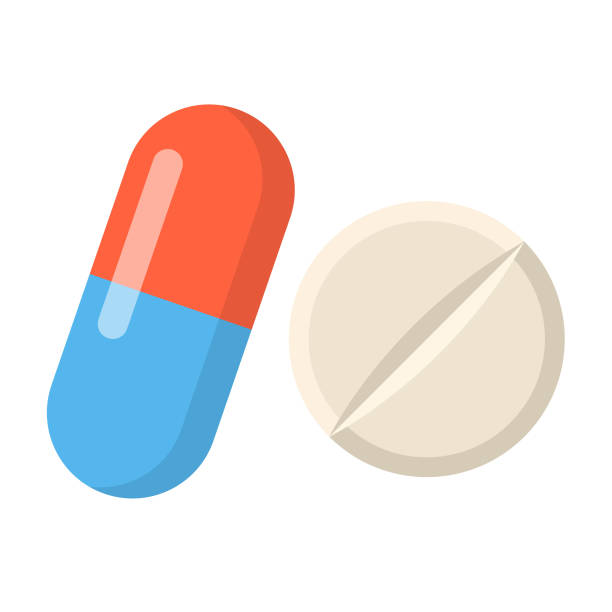Agomelatine
Indications
Agomelatine is indicated for:
- Major depressive disorder especially in non-responders and intolerant to SSRIs
- Generalized anxiety disorder
- Bipolar depression
- Sleep disturbances
- Seasonal affective disorder
- Migraine and cluster headaches
Pharmacology
This compound binds to the melatoninergic receptors and the serotoninergic 5-HT2c receptor giving rise to the Melatonin Agonist and Selective Serotonin Antagonist (MASSA) concept. The melatoninergic receptors MT1 and MT2, are G protein coupled receptors and they act through decreasing cAMP and cGMP. Agomelatine strongly binds to and stimulates the activity of MT1 and MT2 receptors normalizing the disturbed circadian rhythms and disrupted sleep-wake cycles. Unlike the existing antidepressants, agomelatine does not inhibit the uptake of serotonin, norepinephrine or dopamine. It inhibits 5HT-2C receptor (G protein coupled receptor which increases IP3/DAG secondary messenger system) found abundantly in the SCN, frontal cortex, hippocampus and basal ganglia involved in the mood, motor and cognitive deficits associated with depressive states. 5HT-2C receptor antagonism increases norepinephrine and dopamine levels in the frontal cortex of the brain. This action of agomelatine produces antidepressant, antianxiety and also increases slow-wave sleep which is decreased in depression. It has been observed that it can increase neurogenesis in the hippocampus and may also have neuroprotective effects (by influencing glutamate release, glucocorticoid receptor gene expression and various neurotropic factors) which might also contribute to its antidepressant effects. A study has shown that agomelatine alleviates sleep disturbances after one week of therapy and by two weeks antidepressant effects manifest. The combined actions of agomelatine at MT1, MT2, and 5HT-2C receptors can improve the disturbed circadian rhythm and abnormal sleep pattern thus produce the antidepressant effect. These unique effects suggest that it might be effective for the treatment of seasonal affective disorder like anxiety and bipolar depression.
Dosage And Administration
The effective dose of agomelatine is 25 mg per day given once at bed time for two weeks and can be increased to 50 mg per day in patients with inadequate response. Night time dosing is recommended because agomelatine improves the quality of sleep without day time sedation.
Administration
For oral administration with or without food. Most adult patients should take a dosage of 25 mg (one tablet) daily. It is usually taking prior to bed time. If no improvement is noticed after two weeks, the dosage can be increased to 50 mg (two tablets) daily.
Interaction
Potential interactions affecting agomelatine: Agomelatine is metabolised mainly by cytochrome P450 1A2 (CYP1A2) (90%) and by CYP2C9 (10%). Medicinal products that interact with these isoenzymes may decrease or increase the bioavailability of agomelatine. Fluvoxamine, a potent CYP1A2 and moderate CYP2C9 inhibitor markedly inhibits the metabolism of agomelatine resulting in a 60-fold (range 12-412) increase of agomelatine exposure. Consequently, co-administration of agomelatine with potent CYP1A2 inhibitors (e.g. fluvoxamine, ciprofloxacin) is contraindicated.
Contraindications
It is contraindicated in patients with hepatic impairment and hypersensitivity to the active substances or any of the excipients.
Side Effects
The commonly reported adverse effects in the clinical trials of agomelatine are headache, nausea and diarrhea.
Pregnancy And Lactation
For agomelatine, no clinical data on exposed pregnancies are available. Animal studies do not indicate direct or indirect harmful effects with respect to pregnancy, embryonal/foetal development, parturition or postnatal development (see Toxicology: Preclinical Safety Data under Actions). Caution should be exercised when prescribing to pregnant women. It is not known whether Agomelatine is excreted into human milk. agomelatine or its metabolites are excreted in the milk of lactating rats. Potential effects of agomelatine on the breastfeeding infant have not been established. If treatment with agomelatine is considered necessary, breastfeeding should be discontinued.
Precautions And Warnings
It is found to increase the level of liver enzymes and so monitoring of enzyme level is warranted before starting therapy and therefore every 6 weeks.
Overdose Effects
There is limited experience with agomelatine overdose. During the clinical development, there were a few reports of agomelatine overdose, taken alone (up to 450 mg) or in combination (up to 525 mg) with other psychotropic medicinal products. Signs and symptoms of overdose were limited and included drowsiness and epigastralgia. No specific antidotes for agomelatine are known. Management of overdose should consist of treatment of clinical symptoms and routine monitoring. Medical follow-up in a specialised environment is recommended.
Therapeutic Class
Atypical anti-depressant drugs
Use in special populations
Children under 18 years: Should be given only on medical advice.
Children and adolescents: Agomelatine is not recommended in the treatment of depression in patients .
Use in the elderly: Efficacy has not been clearly demonstrated in the elderly (65 years). Only limited clinical data is available on the use of Agomelatine in elderly patients 65 years with major depressive episodes. Therefore, caution should be exercised when prescribing Agomelatine to these patients.
Storage Conditions
Store in a cool and dry place away from light. Keep out of the reach of children.
